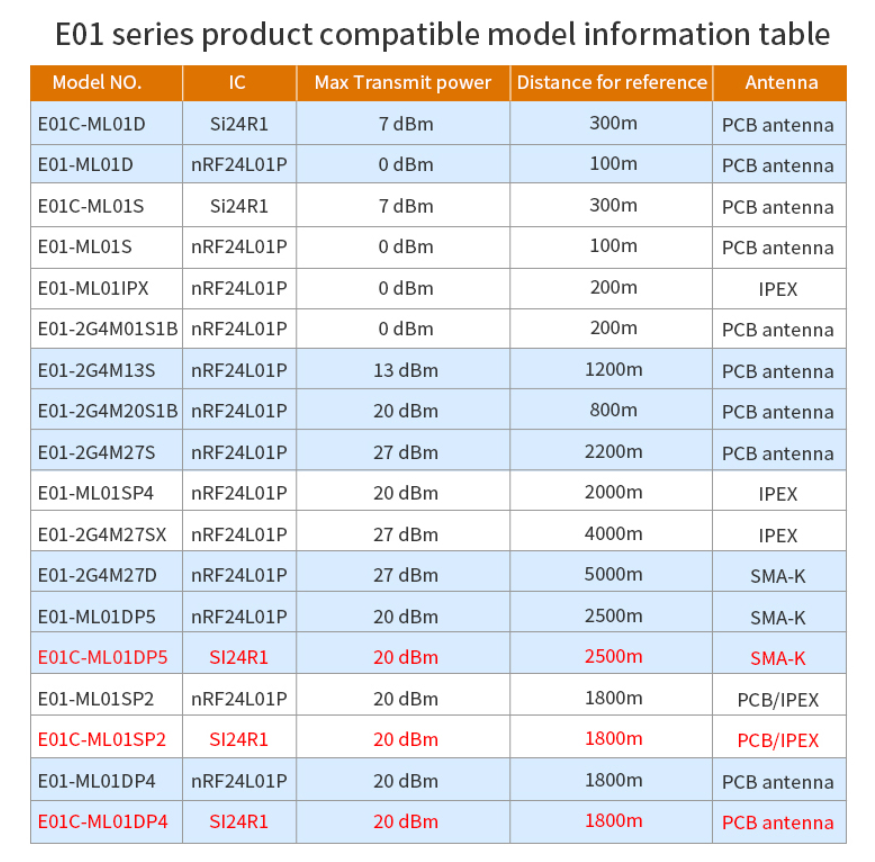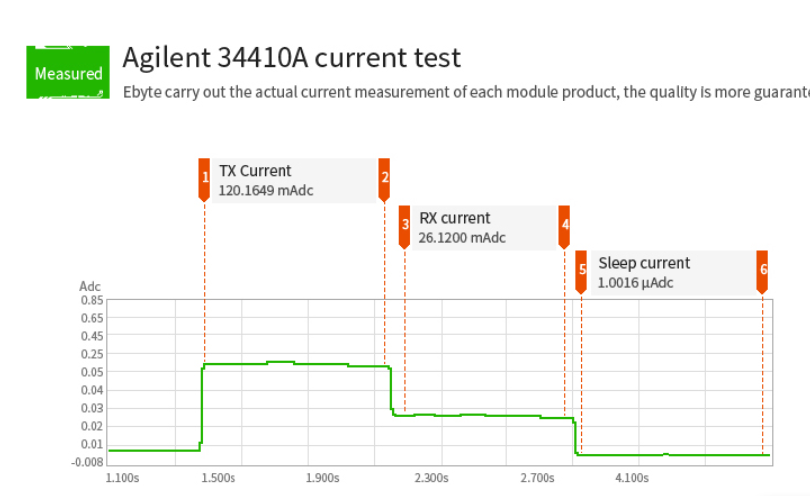Favorite hand solderable radio chip?
-
In some ways it's similar to the nRF24L01, but it's dirt cheap (about 20 cents each) and, unlike an nRF24L01, it's available in a chip package that can be hand soldered:
It has a max transmit power of 6db from just the chip itself, though I suppose that could be boosted with a suitable external PA.
That makes it the only radio chip I've seen that can be easily hand soldered, and so obviates the need for a module. If you prefer it mounted in a module, though, the complete package is just 51 cents:
There's a github library for using it. I found this datasheet, but there might be better ones:
https://www.plexishop.it/pdf/LT89202.4G.pdf
According to that datasheet, the sleep current is just 1ua with full register retention.The intro to the datasheet says it supports frequency hopping, but doing a speed read I didn't see anything further on that. I haven't really looked, but I suspect there may be a more complete datasheet somewhere.
It's definitely old school technology, but it's dirt cheap and hand solderable.
-
In some ways it's similar to the nRF24L01, but it's dirt cheap (about 20 cents each) and, unlike an nRF24L01, it's available in a chip package that can be hand soldered:
It has a max transmit power of 6db from just the chip itself, though I suppose that could be boosted with a suitable external PA.
That makes it the only radio chip I've seen that can be easily hand soldered, and so obviates the need for a module. If you prefer it mounted in a module, though, the complete package is just 51 cents:
There's a github library for using it. I found this datasheet, but there might be better ones:
https://www.plexishop.it/pdf/LT89202.4G.pdf
According to that datasheet, the sleep current is just 1ua with full register retention.The intro to the datasheet says it supports frequency hopping, but doing a speed read I didn't see anything further on that. I haven't really looked, but I suspect there may be a more complete datasheet somewhere.
It's definitely old school technology, but it's dirt cheap and hand solderable.
Follow up: Hmmm... I guess I had been looking in all the wrong places for hand solderable RF ic's in the past, because looking on LCSC just now I easily found 131 different hand solderable transceiver chips:
https://lcsc.com/products/RF-Transceiver-ICs_542.html
including ones (like the hopeRF one) with even lower sleep currents (60na in the case of the CMT2210). And that one doesn't even need an MCU to operate. A number of them cost less than 10 cents each quantity 5, and a number are less than 20 cents each quantity 1. Wow, that really is dirt cheap!Costing more but still cheap ($0.67 in quantity 10) the CMT2157A has a sleep current on <20na with no MCU required, and Tx power can be as high as 13db.
If I relax the hand soldering requirement, there's more than a thousand different chips to choose from. :sunglasses: For dead simple applications, like wirelessly reporting a contact closure, maybe this is all you need. I presume that even battery levels (and/or perhaps other analog measurements) could be crudely reported wirelessly, and though not as satisfying or as accurate, it might be "good enough," especially if the total cost is extremely low. Because of the cheapness, the era of wireless dust has arrived. :grinning:
TL;DR: older wireless chips, about 10% of it hand-solderable and some are standalone and/or of western origin--are very cheaply available via China. The emphasis here is hand-solderable and super cheap.
I realize this is outside the current scope of mysensors, but wireless markets do evolve, especially when driven by economic advantage. Or is it better to stick with one platform which does it all? It's a trade-off.
Anyone reading this have any particular favorites, or even any interest in this?
-
Follow up: Hmmm... I guess I had been looking in all the wrong places for hand solderable RF ic's in the past, because looking on LCSC just now I easily found 131 different hand solderable transceiver chips:
https://lcsc.com/products/RF-Transceiver-ICs_542.html
including ones (like the hopeRF one) with even lower sleep currents (60na in the case of the CMT2210). And that one doesn't even need an MCU to operate. A number of them cost less than 10 cents each quantity 5, and a number are less than 20 cents each quantity 1. Wow, that really is dirt cheap!Costing more but still cheap ($0.67 in quantity 10) the CMT2157A has a sleep current on <20na with no MCU required, and Tx power can be as high as 13db.
If I relax the hand soldering requirement, there's more than a thousand different chips to choose from. :sunglasses: For dead simple applications, like wirelessly reporting a contact closure, maybe this is all you need. I presume that even battery levels (and/or perhaps other analog measurements) could be crudely reported wirelessly, and though not as satisfying or as accurate, it might be "good enough," especially if the total cost is extremely low. Because of the cheapness, the era of wireless dust has arrived. :grinning:
TL;DR: older wireless chips, about 10% of it hand-solderable and some are standalone and/or of western origin--are very cheaply available via China. The emphasis here is hand-solderable and super cheap.
I realize this is outside the current scope of mysensors, but wireless markets do evolve, especially when driven by economic advantage. Or is it better to stick with one platform which does it all? It's a trade-off.
Anyone reading this have any particular favorites, or even any interest in this?
-
@NeverDie I would say that many more chips (such as nrf24, nrf52832 and others in QFN package) become easily hand-solderable if you buy 20-30$ hot-air gun.
-
@NeverDie stencil would help, for sure. But I am talking bare minimum. You tin the pads a little, so they are like bumps, then apply gel flux, put the IC aligned to the pins and reflow it with hot-air gun. That may be not the best practice, but it works, if you need to solder few IC's.
-
@NeverDie stencil would help, for sure. But I am talking bare minimum. You tin the pads a little, so they are like bumps, then apply gel flux, put the IC aligned to the pins and reflow it with hot-air gun. That may be not the best practice, but it works, if you need to solder few IC's.
@monte said in Favorite hand solderable radio chip?:
@NeverDie stencil would help, for sure. But I am talking bare minimum. You tin the pads a little, so they are like bumps, then apply gel flux, put the IC aligned to the pins and reflow it with hot-air gun. That may be not the best practice, but it works, if you need to solder few IC's.
I confirm it works, if you don't put too much solder. I do like this with TSOP style packages too, because it's way easier than using a soldering iron.
-
I read somewhere that China calls the SI24R1 their "domestic" radio. It's a clone of the nRF24L01, but I like it better because it has a Tx power of 7db rather than the anemic 0db of the nRF24L01. Costs about 50 cents per chip, which makes it a reasonable compromise over opting for something cheaper but less compatible. If you haven't seen it, Ebyte has a parallel line-up that uses it (it's nice that they're careful to separate it out onto different modules from the real mccoy):

(source: https://www.ebyte.com/en/product-view-news.aspx?id=1304)Worthy of note is that the range with the SMA-K connector is so much better, assuming their chart is accurate. I mean 2500m as compared to 800m for the same 20db Tx?
Also pretty cool now is that ebyte shows the current traces for tx, rx, and sleep on their modules, so it's easier to directly compare the SI24R1 clone modules to the real thing:

-
I read somewhere that China calls the SI24R1 their "domestic" radio. It's a clone of the nRF24L01, but I like it better because it has a Tx power of 7db rather than the anemic 0db of the nRF24L01. Costs about 50 cents per chip, which makes it a reasonable compromise over opting for something cheaper but less compatible. If you haven't seen it, Ebyte has a parallel line-up that uses it (it's nice that they're careful to separate it out onto different modules from the real mccoy):

(source: https://www.ebyte.com/en/product-view-news.aspx?id=1304)Worthy of note is that the range with the SMA-K connector is so much better, assuming their chart is accurate. I mean 2500m as compared to 800m for the same 20db Tx?
Also pretty cool now is that ebyte shows the current traces for tx, rx, and sleep on their modules, so it's easier to directly compare the SI24R1 clone modules to the real thing:

-
@NeverDie so is it directly compatible with nordic's protocol? Can it be used as drop-in replacement for nrf24?
@monte said in Favorite hand solderable radio chip?:
@NeverDie so is it directly compatible with nordic's protocol? Can it be used as drop-in replacement for nrf24?
From MyConfig.h (obviously the assumed vendor is wrong :) )
There are some settings also to fix the ACK that is reversed compared to NRF24./**
- @defgroup RF24SettingGrpPub RF24
- @ingroup TransportSettingGrpPub
- @brief These options are specific to the RF24 family of wireless transport modules.
- The following chips are supported by this driver:
-
Vendor Chip Nordic Semiconductor nRF24L01 nRF24L01+ Beken Corporation BK2401 BK2421 BK2491 Hope Microelectronics RFM70 RFM73 Panchip Microelectronics XN297 Silicon Labs(?) SI24R1 - @{
